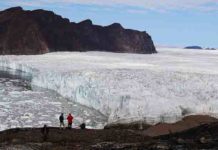
Following Earth’s last ice age, which peaked 20,000 years ago, the Antarctic warmed between two and three times the average temperature increase worldwide, according to a new study by a team of American geophysicists.
The disparity — Antarctica warmed about 11 degrees Celsius, nearly 20 degrees Fahrenheit, between about 20,000 and 10,000 years ago, while the average temperature worldwide rose only about 4 degrees Celsius, or 7 degrees Fahrenheit — highlights the fact that the poles, both the Arctic in the north and the Antarctic in the south, amplify the effects of a changing climate, whether it gets warmer or cooler.
The calculations are in line with estimates from most climate models, proving that these models do a good job of estimating past climatic conditions and, very likely, future conditions in an era of climate change and global warming.
“The result is not a surprise, but if you look at the global climate models that have been used to analyze what the planet looked like 20,000 years ago — the same models used to predict global warming in the future — they are doing, on average, a very good job reproducing how cold it was in Antarctica,” said first author Kurt Cuffey, a glaciologist at the University of California, Berkeley, and professor of geography and of earth and planetary sciences. “That is noteworthy and a confirmation that we know how the system works.”
These models currently predict that as a result of today’s global climate change, Antarctica will warm twice as much as the rest of the planet, though it won’t reach its peak for a couple of hundred years. While the most likely climate change scenario, given business-as-usual greenhouse gas emissions, is a global average increase of 3 degrees Celsius (5 degrees Fahrenheit) by 2100, the Antarctic is predicted to warm eventually by around 6 degrees Celsius (10 degrees Fahrenheit).
The new results, which are the first good calculation of Antarctica’s ice age temperature and the amount of warming since, do rule out a couple of climate models that do not include enough feedback to accurately reproduce the amplified temperature in the polar regions, Cuffey said.
Cuffey and his colleagues, including Gary Clow of the U.S. Geological Survey in Lakewood, Colorado, published their results online last week in the early edition of the Proceedings of the National Academy of Sciences.
Deglaciation in Antarctica
The analysis is based on the fact that as the world warmed following the coldest part of the last ice age 20,000 years ago, the ice deep inside the Antarctic glaciers warmed more slowly than Earth’s surface, just as a frozen turkey put into a hot oven will still be cold inside even after the surface has reached oven temperature. By measuring the remaining difference — the 20,000-year old ice deep in the West Antarctic ice sheet is about 1 degree Celsius cooler than the surface — the scientists were able to estimate the original temperature based on how fast pure ice warms up.
Clow measured twice, once in 2011 and again in 2014, the temperature in a 3.4-kilometer-deep (2-mile-deep) borehole from which the West Antarctic Sheet Divide ice core had been drilled during an eight-year project that ended in 2011. Ice at the bottom of the borehole was deposited about 70,000 years ago; ice about one-sixth of the way up about 50,000 years ago; and ice about one-third of the way to the surface 20,000 years ago.
Cuffey developed a technique to combine these temperature measurements, which are smoothed as a result of heat diffusion in the ice, with isotopic measurements of old ice to come up with an estimated temperature of 11.3 degrees, plus or minus 1.8 degrees Celsius, warming since the depths of the ice age.
Interestingly, the Antarctic temperature increased much more rapidly than did Arctic temperatures after the glacial maximum. By 15,000 years ago, Antarctica had warmed to about 75 percent of its temperature today. The Arctic took another 3,000-4,000 years to warm this much, primarily because of the fact that the Northern Hemisphere had huge ice sheets to buffer warming, and the fact that changes in ocean currents and Earth’s orbital configuration accelerated warming in the south.
Antarctica was also more sensitive to global carbon dioxide levels, Cuffey said, which increased as the global temperature increased because of changing ocean currents that caused upwelling of carbon-dioxide-rich waters from the depths of the ocean.
The situation today, with global warming driven primarily by human emissions of carbon dioxide from burning fossil fuels, is different from natural cycles, he said. The ability of the oceans to take up carbon dioxide cannot keep up with the rising levels of greenhouse gases in the atmosphere, which means carbon dioxide and global temperatures will continue to increase unless humans cut their carbon dioxide emissions.
Reference:
Kurt M. Cuffey, Gary D. Clow, Eric J. Steig, Christo Buizert, T. J. Fudge, Michelle Koutnik, Edwin D. Waddington, Richard B. Alley, Jeffrey P. Severinghaus. Deglacial temperature history of West Antarctica. Proceedings of the National Academy of Sciences, 2016; 201609132 DOI: 10.1073/pnas.1609132113
Note: The above post is reprinted from materials provided by University of California – Berkeley.










